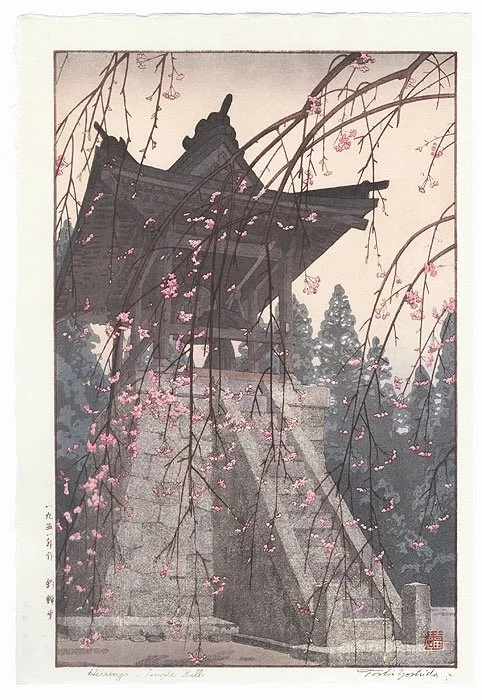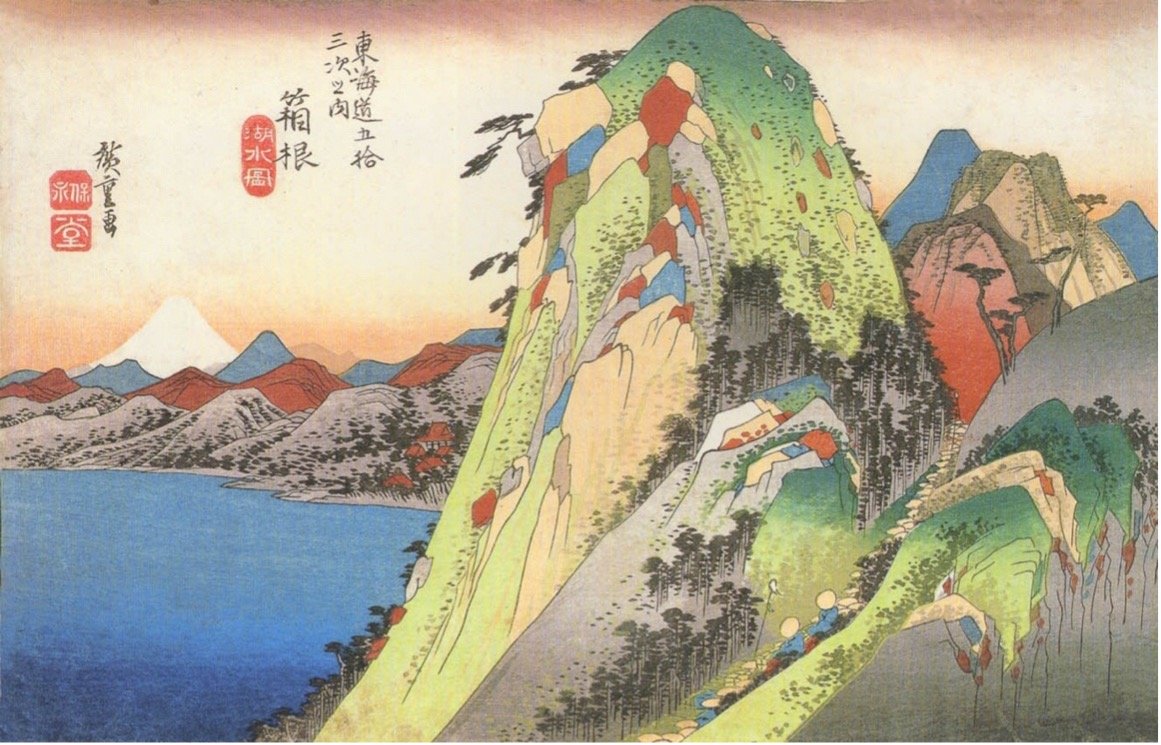Japanese Wood Block Printing
Yoshida - Three Generations of Japanese Printmaking at the Dulwich Picture Gallery
HIROSHIGE: ARTIST OF THE OPEN ROAD IS NOW SHOWING AT THE BRITISH MUSEUM
1ST MAY - 7TH SEPTEMBER 20205
Heirinji Temple Bell, 1951 by Toshi Yoshida
This woodblock print is one of two that we purchased during our visit to Japan back in 2019. It is Heirinji Temple Bell, 1951 by Toshi Yoshida, created just a year after the death of his more famous father Hiroshi Yoshida of whom I will return to later. This piece was created just before the point of divergence from his father’s style towards a more abstract and experimental style that characterised the latter part of his work. Consider it for a moment.
What do you notice first, what do you feel, where is your eye led? It may be that the soft peach pink and grey green hues generate a sense of calm, it might be the timeless traditional form of the temple itself seen from a low viewpoint that emphasises a sense of ascension, maybe something spiritual. Perhaps the decorative pattern of the blossom creates a slight flatness against which the semi-obscured space behind emerges.
Look closer, however. Almost hidden from view, inside the temple a man can be seen holding a long wooden pole about to strike the bell.
Here is the genius of this piece. When I look at this seemingly frozen timeless piece, there is a moment of action and with it a sound. In my mind the gong of the bell rings out and continues its echo for an extended period. Incorporated into this piece is time along with the space. What is the allure and genius of these woodcut prints and how did they develop, influence and be influenced by western art.
Ukiyo-e (pictures of the floating world) refer to the flourishing of woodcut prints and paintings from the 16th to the 19th century in Japan. Let’s not forget how cheaply and widely available these woodcuts prints were, refreshing when you consider Arts enduring elitist history. Hokusai of course is perhaps the best known of the Japanese woodcut artists working towards the latter end of this period, and if we try to view such familiar pieces with fresh eyes, we realise how some of his imagery is daringly abstract to Western eyes of the time and beyond.
Katsushika Hokusai, ‘Thunderstorm Beneath the Summit’ (Sanka hakuu), 1830-1832, Metropolitan Museum of Art.
Katsushika Hokusai, ‘The suspension bridge on the border of Hida and Etchu provinces’, 1834
Looking at less well-known pieces perhaps gives us a fresh insight into how cleverly these pieces are constructed. In the piece above, the shape of the foreground barely tinted, is created through negative space, but is essentially the bare ground of the paper, so it seems there and not there. What gives this ground form is the space created by the green trees behind. Follow the sinuous edge that is left floating above the precipice with the rock on the right plunging into it, implies a surrealistic landscape only accentuated by the hovering figures above. Notice, also the blue mountain above that fades and disappears into the clouds below.
Utagawa Hiroshige, a pupil of Hokusai, is seen to have a direct influence on Western art and the Impressionists in particular, as these woodcuts and other artworks started to flood into Europe during the Meiji restoration (1863), the opening up of Japan after more than 200 years of isolation.
Perhaps the most well-known example of Hiroshige’s influences is that of Van Gogh responses.
For me these aren’t developing deep and meaningful translations, but rather have a rather touching feel of an excited student paying homage to exciting influences by completing an honest pastiche in their style. Minor variations in colour exist, but it’s Van Gogh’s trademark impasto style that diverts from the original most bringing a perhaps disturbing physicality rather than the effervescent ombres of Hiroshige. Later on, Van Gogh did incorporate elements further into his pioneering style with flat abstracted development of colour.
Flowering Plum Orchard (after Hiroshige), 1887
Kameido Umeyashiki, 1857
Less well known is the influence of Japanese sensibilities is in the work of James McNeill Whistler. An interesting and I feel slightly underestimated artist who though often allied with the Impressionists, is much more individual a painter.
James McNeill Whistler, ‘Nocturne: Blue and Gold — Old Battersea Bridge’, 1872-75, Tate Britain
Utagawa Hiroshige, ‘Kyobashi Takegashi’, 1857
Clear examples of unusual compositional influences from Hiroshige exist in the painting of Battersea bridge (above) and experimental techniques in obscured forms in The Falling Rocket (below). This painting was at the centre of the infamous Ruskin vs Whistler trial where in response to being asked how he could charge 200 guineas for a painting that took two days, Ruskin replied that he charges it ‘for the knowledge I have gained in a lifetime’.
James McNeill Whistler, ‘Nocturne in Black and Gold – ‘The Falling Rocket’, 1877, Detroit Institute of the Arts
Utagawa Hiroshige, ‘Ryogoku Hanabi’, 1858
This trial was crucial in defining the conceptual value of an artist and perhaps refers to the economy of means and simplicity of design that Whistler learned from Japonisme from 1864 onwards. He is such a ground-breaking artist, and these aspects were part of the drift towards the exploration of abstraction as can be seen in ‘Nocturne: Grey and Silver’ below from 1873-5. This piece was painted at the same time as Monet’s ‘Impression: Sunrise’, deemed to be the first Impressionist painting. Whistler’s painting for its time is an incredibly radical painting reminiscent of Rothko, but also links to the lost forms and empty spaces of so many Japanese painters of which perhaps the finest example is ‘Pine Trees’ by Hasegawa Tohaku dating all the way back in 1595. I find the difference between what was happening in Renaissance religious art at this time with its drive towards realism and the application of perspective, and abstracted pieces such as Tohaku’s beguiling. Both refer to spirituality in some form, but in completely different ways.
James McNeill Whistler, ‘Nocturne: Grey and Silver’, 1873-5
Hasegawa Tohaku, ‘Pine Trees’ (Shōrin-zu byōbu), folding screen, c1595.
Much more could be said for the revolution in pictorial space, cropped images, obscuring elements in the foregrounds that Hiroshige’s compositions engendered in the work of Gauguin, Degas, Toulouse-Lautrec and many others and was part of other influences that led towards abstraction. Also, much was learnt as regards to the abstracting use of colour and shapes and the interplay between flatness and depth that so many abstract painters explored in the 20th Century as can be seen in the pieces below.
Hiroshige
Hakone view of the lake Noriyuki, 1834
The influence was not a one-way conversation, however. How was Japanese art and the woodblock tradition developed after contact with Western Artistic principles? Let us return to Hiroshi Yoshida.
Hiroshi Yoshida was born in 1876 and was schooled in Western style Japanese painting taking on elements of perspective and a greater focus on observational detail and the effects of light and colour. He travelled widely organising his first exhibition in the U.S. in 1899 and visited the U.S. on several occasions as well as Europe and India. A proponent of the Shin-Hanga style, his themes remained strictly along Ukiyo-e lines such as landscape, famous places and birds and flowers.
The pieces below were certainly made to appeal to western eyes. There is a renewed interest in capturing an atmosphere through the depiction of light and the colours are highly developed. The intensity is created via a process of up to 100 layers of repeat printing to achieve a depth, complexity, and resonance. I love the graphic edge to the areas of colour which is reminiscent of the comic book styles that so influenced Pop Art many years later and influences many areas of Japanese arts including Manga and Anime.
Fuji New Grand Hotel - Lake Yamanaka, 1937
Glittering Sea, 1926
Like the Impressionists, they capture the growing importance of travel to larger populations due to the explosion of the railway system that revolutionised society. In fact, many were collected as mementos for places visited. The compositions are expansive, though space is somehow shortened at the same time with the use of a high horizon. There’s a large element of nostalgia, but like so much of Japanese Art, they exude calm and soul, not to mention that strange sense of a timeless moment captured.
Yoshida Hiroshi: ‘Grand Canyon’, 1925
I find this series of sailing boats fascinating in that through the use of a single wood block composition, an endless series of atmospheres are expressed at a multitude of different times of the day. This recalls Monet’s many series paintings and similarly look with interest at subtle shifts and combinations of colour hues. It’s a reminder that though prints such as these were more democratically available to the public, each one is still hand printed and therefore has a slightly unique combination of colour. This range of colour developed through ombres of light to dark vary from misty, dusky hues through to other daytime pieces with much more clarity.
Hansen (Sailing boats) from the series Seto naikai shû (Seto Inland Sea collection), 1926
Studio Ghibli, ‘Spirited Away’, 2001
The influence of these prints on the course of western and global art therefore cannot be underestimated along with other key technological and conceptual innovations that revolutionised the world of the Impressionists and changed what art aspired to achieve. The impressionists were well known to have collected these prints but moving into the 20th Century so did many other western artists such as the Abstract Expressionists, the Expressionists, and Viennese artists such as Schiele and Klimt amongst many others. They have an enduring legacy and thankfully are still widely available at prices that won’t make your eyes water. We at Marrikur find much that influences us and there are similarities with the wood block printing process and our marquetry which I will discuss in a second blog that will also look deeper at other Japanese influences on western art. For now, though I will look at Toshi Yoshida’s print and wait for that bell to ring.




















